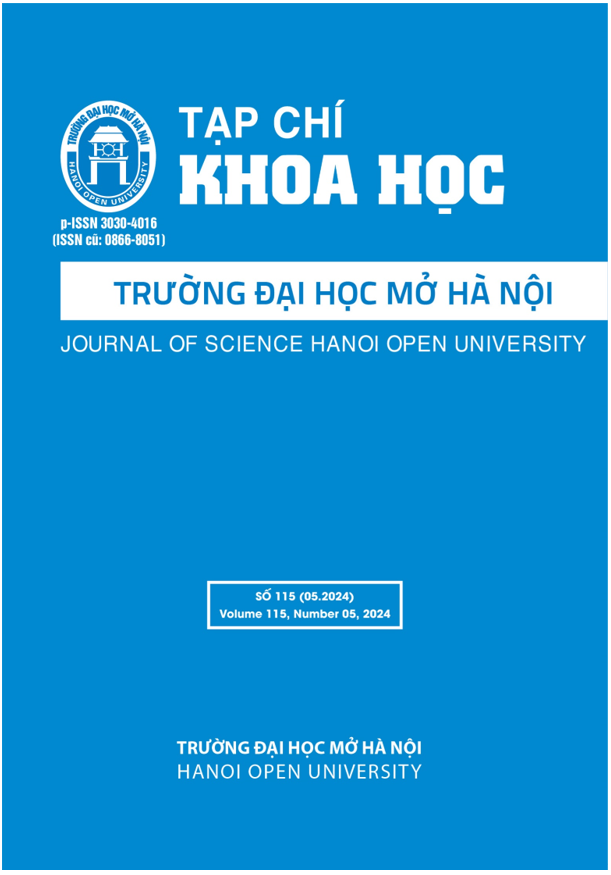NGHIÊN CỨU ĐIỂN HÌNH NHẬN THỨC CỦA SINH VIÊN TIẾNG ANH CHUYÊN NGÀNH VỀ NHU CẦU MỤC TIÊU TẠI TRƯỜNG ĐẠI HỌC KINH TẾ KỸ THUẬT CÔNG NGHIỆP
DOI:
https://doi.org/10.59266/houjs.2024.397Keywords:
Tiếng Anh chuyên ngành của sinh viên UNETI, phân tích nhu cầu, mục tiêuAbstract
Mục đích của nghiên cứu này là xác định nhu cầu mục tiêu của sinh viên (SV) tham gia chương trình chuyên ngành do Khoa Ngoại Ngữ trường đại học Kinh tế Kỹ thuật Công nghiệp (UNETI) ở Việt Nam cung cấp. Một mẫu gồm 84 sinh viên (N=84) đã tham gia vào nghiên cứu này. Dữ liệu định lượng được thu thập thông qua bảng câu hỏi phân tích nhu cầu trước và dữ liệu định tính được thu thập từ một cuộc phỏng vấn bán cấu trúc liên quan đến nhận thức về nhu cầu mục tiêu của sinh viên. Kết quả nghiên cứu cho thấy chương trình tiếng Anh Chuyên Ngành (TACN) nên tập trung vào việc sử dụng hiệu quả các chiến lược ngôn ngữ trong các nhiệm vụ nhất định như cải thiện kỹ năng thuyết trình, học các thuật ngữ chính, viết email và đọc các văn bản học thuật.
References
[1]. Altschuld, J. W., & Witkin, B. R. (1995). Planning and conducting needs assessments: A practical guide. California: Sage Publications.
[2]. Bogdan, R. C., & Biklen, S. K. (1998). Qualitative research for education: An introduction to theory and methods. Ally & Bacon: Needham Heights, MA.
[3]. Brown, J. D. (1995). The elements of language curriculum. Boston: Heinle and Heinle.
[4]. Cherry, K. (2018). How Maslow’s famous hierarchy explains human motivation. Retrieved May 15, 2019.
[5]. Edwards, N. (2000). Language for business: Effective needs assessment, syllabus design and materials preparation in a practical ESP case study. English for Specific Purposes, 19, 291-296.
[6]. Ekici, N. (2003). A needs assessment study on English language needs of the tour guidance students of faculty of applied sciences at Başkent University: A case study. Unpublished Master’s Thesis. Middle East Technical University, Ankara.
[7]. Goonetilleke, D. C. (1989). Language planning and ESP with special reference to Sri Lanka. In P. W. Peterson (Ed.), ESP in practice (pp. 41-46). Washington, DC: United States Information Agency.
[8]. Hutchinson, T., & Waters, A. (1987). English for Specific Purposes: A learning-centered approach. Cambridge: Cambridge University Press.
[9]. Lavinia, N. (2017). ESP teaching and needs analysis. Case study. Economic Sciences Series, 17(2), 268-273.
[10]. McLeod, S. (2007). Behaviorist approach. Retrieved May 17, 2019, from http://www.simplypsychology. org/ be ha vi ori sm .ht m l #st ha sh. IFZMW9pB.dpbs
[11]. Mutlu, Ö. (2004). Aneeds analysis study for the English-Turkish translation course offered to management students of the faculty of economic and administrative sciences at Başkent University: A case study. Unpublished Master’s Thesis. Middle East Technical University, Ankara.
[12]. Ozkanal, U. (2009). The evaluation of English preparatory program of Eskişehir Osmangazi University Foreign Languages Department and a model proposal. Unpublished Dissertation. Anadolu University, Eskişehir.
[13]. Rossi, P. H., Lipsey, M. W., & Freeman, H. E. (2004). Evaluation: A systematic approach. Sage Publications.
[14]. Tomlinson, B. (2011). Material development in language teaching. Cambridge, UK: Cambridge University Press.
[15]. Widdowson, H. G. (1998). The theory and practice of critical discourse analysis. Applied Linguistics, 19(1), 136-151.
